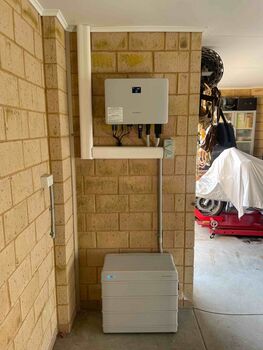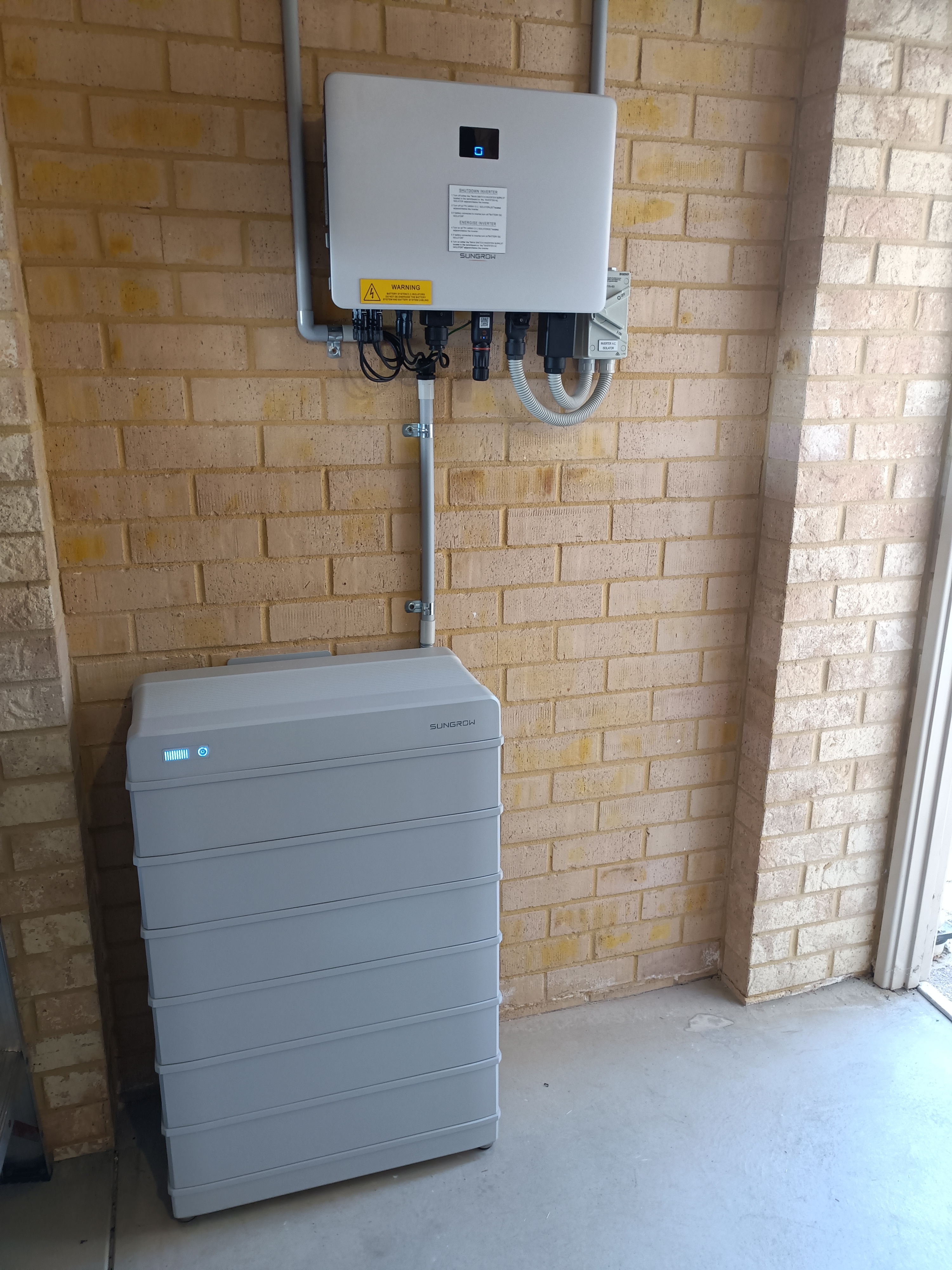Sungrow Solar inverter review - Updated October 2024
Since Sungrow released their high-voltage SBR battery, we have installed a great many Sungrow inverter + battery combos. (08) 9467 9655
Pictured here is an install we did of a 10kW three phase Sungrow inverter and 22kWh of Sungrow SBR batteries.

Our installers and I love the Sungrow products.
Robustly made. You can touch and feel the higher quality compared to many other brands.
Easy to install, very neat, ultra-compact battery, well featured and excellent reporting.
As usual, reporting via the iSolarCloud website is much more detailed than via the phone app.
A larger screen allows for more information.
Sungrow inverter range.
We mostly install the Sungrow hybrids (solar & battery) but they do have regular 'solar only' products.
There is a 3 x MPPT 5kW, 8kW and 10kW single phase 'solar only' range, the 0RS-ADA range.
Quite expensive but having those 3 x MPPTs can make all the difference for some people's rooftop.
A cheaper 5kW and 2 x MPPT model is available, model "0RS" without "ADA" on the end at a more reasonable price.
There are also 5kW, 8kW, 10kW and 15kW, 20kW and 30kW three phase 'solar-only' inverters.
However, it's the Sungrow hybrid range that is what we are selling and installing.
All the Sungrow hybrids come with a consumption meter and backup (blackout protection) as standard.
Fronius use a backup box to provide blackout protection at an extra cost of $1,200 to $1,500 + about $860 install.
A Fronius three phase consumption meter is $400-$600 extra depending on model.
That puts "getting them for free with Sungrow" into some perspective I think.
Sungrow single phase hybrids (SHx.0RS)
As I wrote already... consumption meter and backup included.
Oversize to 200% +, so 10kW-12kW of panels on a 5kW Sungrow inverter with a battery.
Integrates perfectly with Sungrow SBR batteries but you can also connect BYD batteries (but why would you?)
Models : 5kW and 6kW with 2 x MPPTs, 8kW and 10kW with 4 x MPPTs.
Sungrow three phase hybrids (SHx.0RT)
Three phase consumption meter and three phase backup included.
Oversize to 150%, so 7.5kW on a 5kW inverter or 15kW on a 10kW model with a battery.
Same great integration with Sungrow SBR battery (and support for BYD batteries as well).
Models : 5kW and 10kW with 2 x MPPTs, with two parallel strings on one of the 10kW MPPTs.
New three phase Sungrow hybrid models now available...
Models 15kW, 20kW and 25kW all with 3 x MPPTs with parallel strings on the first two of those MPPTs.
That means 5 strings of potentially 14 x 440W panels per string = 30.8kW of panels with a battery.
Each model allows 200% oversizing but it's really only the 15kW model that actually can do it.
The 20kW and 25kW models are defeated on that score by Australia's 600V residential string voltage limit.
We can only live in hope that the powers that be will finally scrap that restriction and give us 1000V strings !!
Sungrow SBR battery
Model : Sungrow SBR.
High-voltage so it can work with both single and three phase Sungrow "SH" model inverters.
High voltage also means much smaller cables, a neater install and allows some distance between inverter and battery.
3.2kWh modules, minimum of 3 (9.6kWh) maximum of 6 (single phase), or 8 (three phase).
If more storage is needed, additional stacks can be connected in parallel.
It's very compact. A 9.6kWh battery stands just 545mm off the ground.
A full stack of 6 x 3.2kWh (19.2kWh, single phase) just 935mm off the ground.
Compare that to a 19.3kWh stack of BYD HVM batteries at 1877mm...double the height.
Lithium Iron Phosphate cells, and a good BMS, this battery is designed for 6,000-8,000 cycles although their warranty says 4000.
4000 cycles at one per day, is only 10.95 years but warranties, and what you actually get, are two very different things.
To put that into perspective, there's a new iStore/Huawei battery coming by mid 2025.
It will be sold in Europe about 6 months before we get it, so released over there pretty soon.
Lithium Iron Phosphate cells, same as Sungrow, albeit in a different prismatic bundle... 15 year/12,000 cycle warranty.
If the cell chemistry and cell quality is the same, the life expectancy, if correctly managed, should be the same.
A new larger capacity Sungrow battery is coming...
There's also a new larger Sungrow battery on the horizon, designed for the new larger three phase inverters.
Sungrow tell me that they are keeping the existing battery which is in 3.2kWh modules for their smaller hybrids.
The new 5kWh module battery is better suited to the larger hybrids.
I'm pretty sure that either battery is going to work with any of their hybrid inverters though.
Sungrow backup (blackout protection).
All the Sungrow hybrids, single and three phase, provide backup built-in.
That means no separate box, but of course the backup has to be cabled and installed in the switchboard.
It usually takes longer to install backup in a switchboard than it does to install the battery and inverter !!
If it's, for example, a 5kW single phase hybrid (which you can also install on three phase with a battery in WA)
you get 5kW/21A of backup power to your essential loads (lights, some outlets).
21A isn't going to power the whole house when the grid goes down.
Switch over time is a few milliseconds but a word of warning.
Those lighting and outlet circuits are running through the inverter ALL the time.
You'll trip the inverter if you overload those circuits even if the grid is working fine.
The three phase inverters split the backup power equally across all three phases.
So a 10kW inverter will deliver 3.3kW per phase.
I see from the new datasheet for the upcoming 15-25kW inverters that they support 100% unbalanced loads in backup.
Call me a skeptic, but I think the devil will be in the detail there.
What it suggests is that in backup, with say 10kW available, you can send 8kW to phase A, and 1kW to B and C phases.
I don't believe that will be the case, but I'm very happy to be proven wrong.
What I think will happen is you will still get a maximum of 3.3kW per phase, but within that, it can be unbalanced...
e.g. 3.3kW on phase A, 2kW on phase B, and 1kW on phase C.
We shall have to wait and see !!
Sungrow WIFI/Ethernet Reporting.
You can use WIFI or hard wire from the inverter to your home router/modem.
Sungrow include the dongle with the inverter.
Apart from a slightly wishy-washy colour scheme in the flow charts, I think Sungrow's reporting is excellent.
It's called iSolarCloud. Much better viewed on a PC using their web browser than the phone app.
Many more reporting features available via the browser too.
Charging your Sungrow battery from the grid...single phase inverter consideration only.
One of the great things about Time of Use tariffs like Synergy's Midday Saver is grid-charging a battery.
If you can't charge your battery consistently just from solar power, top it up for 8c / kWh from the grid instead.
However, with Sungrow and other inverters with built-in back, this presents a problem.
The backup circuits may have loads on them at the same time as you want to charge from the grid.
Remember those backup circuits are running through the inverter and it's AC cable all the time.
The combination of battery charging and backup circuits can mean nearly 60A of current flowing through the AC inverter cable.
That's far too much. So the cable needs to be upgraded to chunky and expensive 16mm cables and the Earth to a 6mm cable.
The usual AC isolator next to the inverter and in the switchboard needs to be changed to a suitably rated breaker too.
That typically adds about $660 to the installation costs and can be much more than that as the length of cable needed increases.
Sungrow support.
Sungrow along with most inverter manufacturers prefer you to seek support through your installer.
They will talk to you if you tell them your installer is useless. It won't surprise them at all.
Their number is 1800 786 476.
Happy to report that Sungrow have just extended their support hours to service WA better.
8.30am to 8pm Eastern time, so for us in WA, that's 5.30am to 5pm in Summer, weekdays. Great !
I've called Sungrow support many times seeking their assistance and they have been ok, not great.
However, recently after a bit of complaining, I have managed to get a 'higher-up' Sungrow support contact who has proven excellent !!
My opinion of Sungrow
I'm very impressed and not with-standing the bug-fixing that went on, so it seems are our clients.


or email
This review was written by Andrew MacKeith, Solar4Ever service manager since 2011.
Solar4Ever is located in Morley (Perth), WA 6062
